---------------------------------------------------------
Where to get chicks
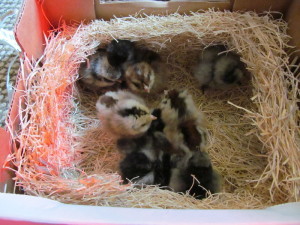
Ready to jump into the wonderful world of chickens? If you are like me, you did your online research, read books & magazines, and were ready to take the plunge. Then you went to buy some chickens and you realized you had no idea where to get them!
In rural areas you might have feed and farm stores nearby, but in urban or suburban areas you might have to search more. I had no idea that in my town I had a small feed store, I drove by it all the time but never really noticed it. Unfortunately, they don’t have live animals for sale, so I had to keep looking. I was able to find one about 30 minutes away that had chicks for sale. A larger store with a bigger selection, I still go there for feed even though it’s further than the in town shop. Other than feed stores, you can also try calling your local 4H Club, searching Craigslist or asking your veterinarian.
Did you know you can also order chickens in the mail? Try My Pet Chicken or Meyer Hatchery. Many hatcheries have large minimum orders, but I have found these two will both ship smaller orders (as little as three chicks depending on the time of year and your climate). The journey can be stressful for the babies, but they generally arrive safe and sound in their heated box. It is always exciting to arrive at your local post office to collect your peeping box of chicks! click here to read more about the process of mail order chicks
The Basic Supplies
Make no mistake, chicks are newborns – they require care and lots of time, just like most newborn animals. For at least the first month you need to be willing to devote a decent amount of time to their care. You will need to check on them several times a day, making sure the temperature is right, cleaning poop & shavings out of their water and food, and socializing them so they will grow up into friendly chickens.
The chicks will need to be kept in a secure indoor space. A barn, garage or basement could be perfect locations. If those locations are not available, you could choose a three season room (if it is warm enough) or a spare bathroom. If you keep the brooder clean, it should not smell terribly bad, but the chick’s constant scratching can produce a lot of dust that can get all over the room. If you don’t think you have the time or space to devote to this, you might want to consider skipping the chick stage and trying to find pullets (2-3 months old) or adult chickens.
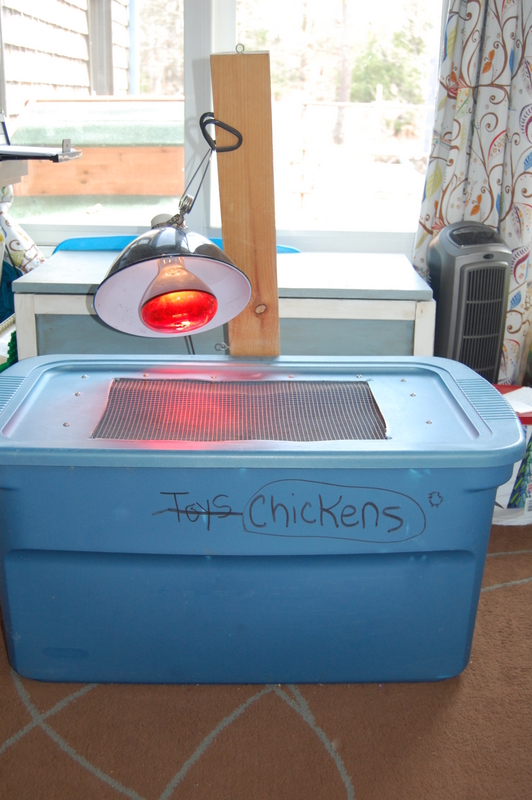
Brooder box for chicks
Chicks will need a secure brooder box to live in for the first several weeks of life – click here to see how I built mine. We have used a few different brooder boxes over the years. Pictured above was our very first brooding set up. As you can see we just grabbed an old plastic tote from the attic and repurposed it. We cut a panel out of the middle of the lid and covered it with hardware cloth to keep the chicks safe from our cats & dogs.
This was great for brooding a small flock. When we wanted a larger space, we decided to go with a clear tote which was much nicer for both us and the chicks. It was easier to see them and had more light for the chicks. Ideally you want to have about 1 square foot of floor space for every 2 chicks in the brooder.
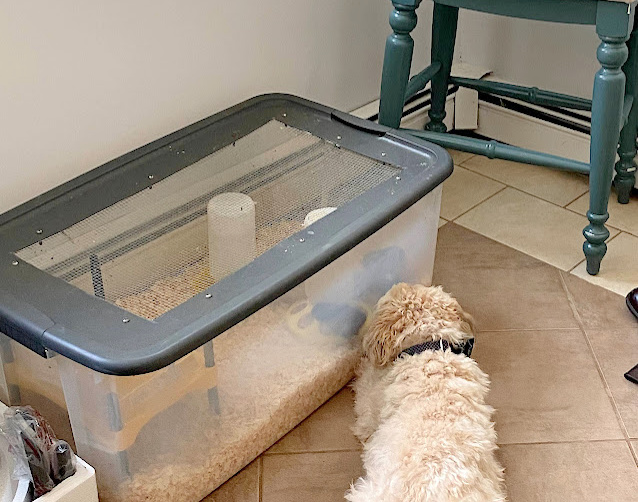
For the last two seasons, we have switched to a pop up dog pen for our brooder. They come in a range of sizes, are easy to clean, provide plenty of ventilation for the chicks, and best of all it folds up flat for storage when not in use.
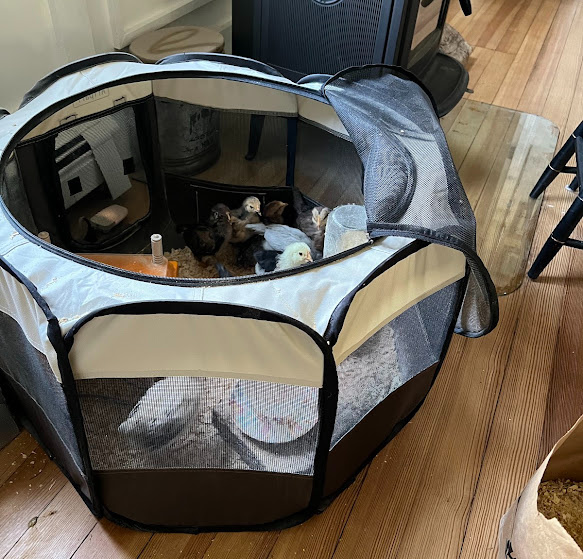
Setting up the Brooder
Line the box with pine shavings, and place the water & feed containers inside. Putting a small brick or block of wood under the water will raise it up and help keep shavings and poop out of it. It will still get in there, chicks are really messy, but keeping it raised will make it a little better! Just be sure the chicks can still easily access the dishes.
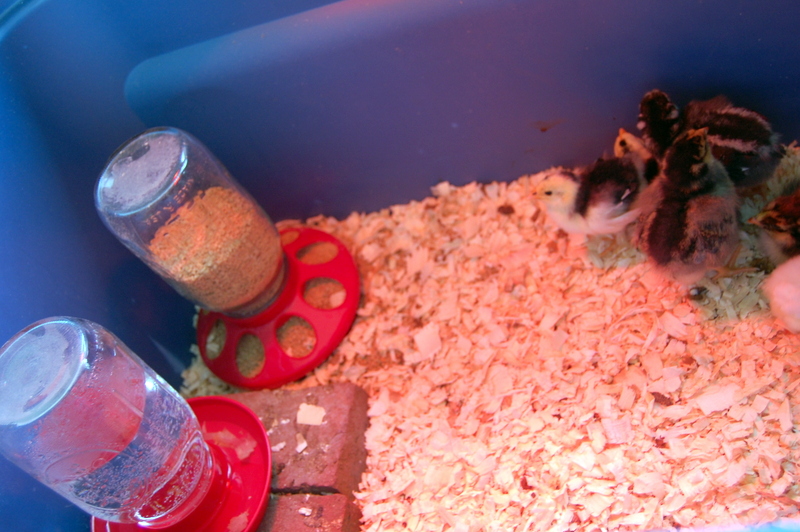
Heat source for chicks
You will also need a heat lamp with a red bulb, and a thermometer to keep an eye on the temperature in there. Aim the heat lamp to one side of the box. You want the chicks to have a warm area they can sit in, but also a cooler area they can escape to if needed.
Using a heat bulb with a red filter is recommended. A clear white light can interfere with the chick’s sleep patterns, and just like a sleep deprived infant, sleep deprived chicks can be very grumpy and pick on each other.
Please note, heat lamps can be a fire hazard if they are knocked over so always use caution and check the lamp often. If you plan to raise chicks often, it is worth the investment of a radiant chick heater like Brinsea Ecoglow. It might be more expensive but it’s much safer, especially if you have pets or little kids around, or if you are brooding your chicks somewhere you can’t monitor often (like a barn, garage or basement). Radiant heaters do use less electricity than a heat lamp, so that helps defray some of the cost.
For the first week of life, your chicks will need an air temperature of 95 degrees. The next week, you will reduce it to 90 degrees, then 85 the next week and so on for about 4-5 weeks. A thermometer is helpful, but the chicks will tell you if their temperature is not right. If they are huddled together and chirping loudly they are too cold, if they are all spread out with their wings out they are too hot. You can adjust the temperature of the air by lowering or raising the heat lamp or raising the legs on a radiant heater.
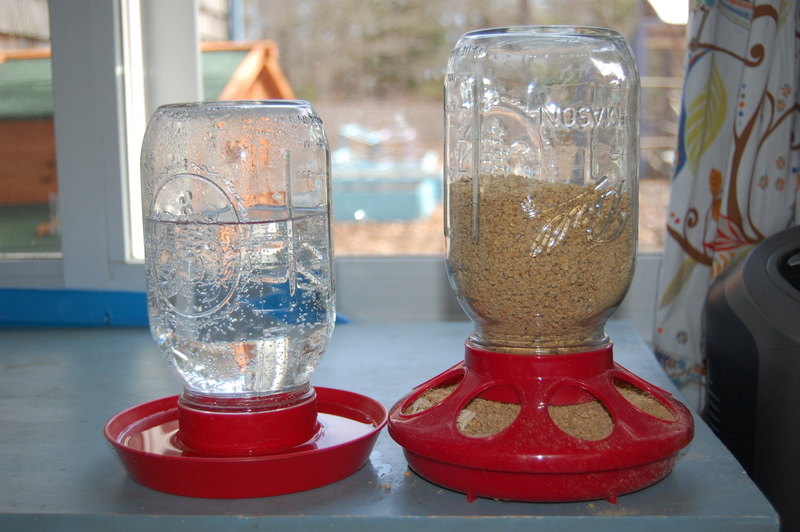
Food & water
At feed stores or online, you can purchase dishes especially made for baby chicks. I would recommend using a dish made for chicks vs an open bowl. If you use an open bowl for water, the chick could fall in and drown, or at the very least they will tip it over and make a mess with it. If you leave out an open bowl of feed they will stand in it, poop in it, and scratch the feed all over the box wasting it. You can pick up bases for feed & water like the ones above for only a couple dollars and you just screw in Mason jars.
You will need to purchase chick starter or grower feed. This will be specially manufactured for the needs of growing chicks. When they are about 16 weeks old and getting ready to lay their first egg, you can transition them to standard layer chicken feed. Click here to read more about feeding chickens for life
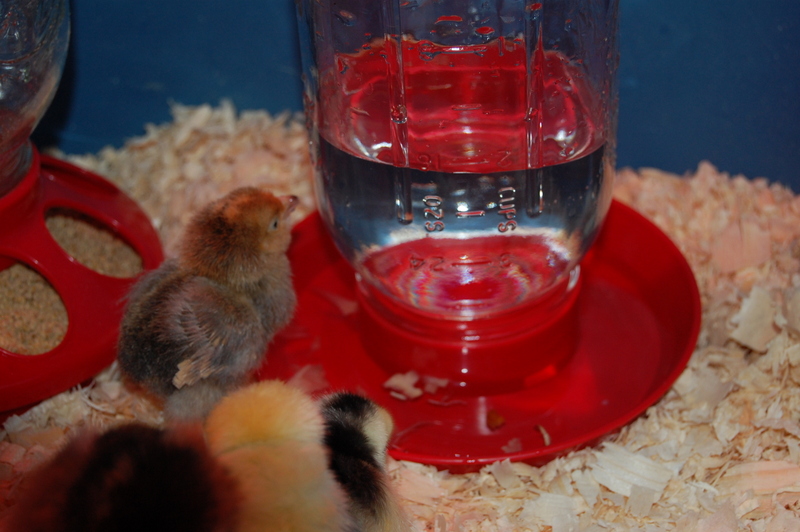
Adult chickens need grit (sand or small pebbles) in their diet to help them digest their food. As long as the chicks are only eating starter feed, they don’t need grit. As soon as you start letting them outside where they eat grass or bugs, or if you add treats to the brooder, you will need to offer a small bowl of grit to the chicks.
Chick Care Checklist
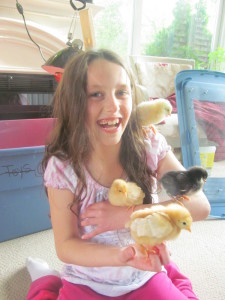
daily – keep their water & feed full and clean
daily – monitor temperature & adjust heat source when needed
daily – health check, make sure everyone is up and moving around. Especially the first day home ensure everyone is eating and drinking. If they are not, gently press their beaks into the food & water.
daily – spend time bonding with the chicks, the more time you put in now, the friendlier your chickens will be as adults.
1-3 times per week – clean the brooder (frequency will depend on amount of chicks and the size of your brooder)
Letting chicks outdoors
When the chicks are about 3 weeks old (and it is at least 50 degrees outside) you can start introducing them to the great outdoors for short periods of time. Do not leave them out there unattended! They are defenseless against any type of predator. You can use a large wire dog kennel or a child’s playpen (as long as the chicks can’t fit through the slats and you put some netting over the top). You can also just let them run in the yard so long as you have lots of “chicken wranglers” to help keep them safe. Mostly they will band together, but you need to be prepared in case one bolts. The chicks will love scratching in the dirt and grass, and I have even seen them dust bathe at this early age!
When the chicks are 4-8 weeks old it’s time for them to move outside full time. The biggest factor in making the decision is the temperature. If it is summer and warm even at night, you can move them out at 4 weeks. If it is chilly at night, you will need to keep them indoors longer. My general rule of thumb is they should be at least 4 weeks old AND it should be at least 50 degrees at night. click here to read more about transitioning chicks outdoors
Pasty Butt
Tip each chick upside down each day to check their vent area. If poop gets clumped on their fluff, it can block their vent resulting in a deadly condition known as “pasting up”. Chicks can easily die from this, and it must be dealt with immediately. You will be able to easily see if this is happening once you pick up the chick. If it happens to your chick, run the chick’s bum under warm running water until the poop is softened. Never pick or pull hardened feces off the chick, their skin is very thin and can tear. Keep a close eye on that chick in the coming days as it is likely to happen again. Some chicks just seem prone to it.
If your chick is only a day or two old, be sure the mess you are seeing is indeed poop on their vent. The vent is the hole just under the tail where droppings come out. Very young chicks will also have the remains of their umbilical cord attached to their lower abdomen. You DO NOT want to pull on this! The cord needs to dry naturally and drop off. If you pull on it, you could disembowel the chick.
Little kids and chicks
Children love chicks, they are cute, fuzzy & downright irresistible. Please monitor children closely to ensure the chicks do not get hurt. Also, chicks poop. A lot. If you hold a chick for 10 minutes you are pretty much guaranteed to get pooped on. We like to put down some newspaper or cardboard on the floor and sit with them as they explore, picking them up and handling them for short periods and then putting them back down to run around. Be sure everyone washes their hands well after handling the chicks, and secure other household pets away when the chicks are out of the brooder.
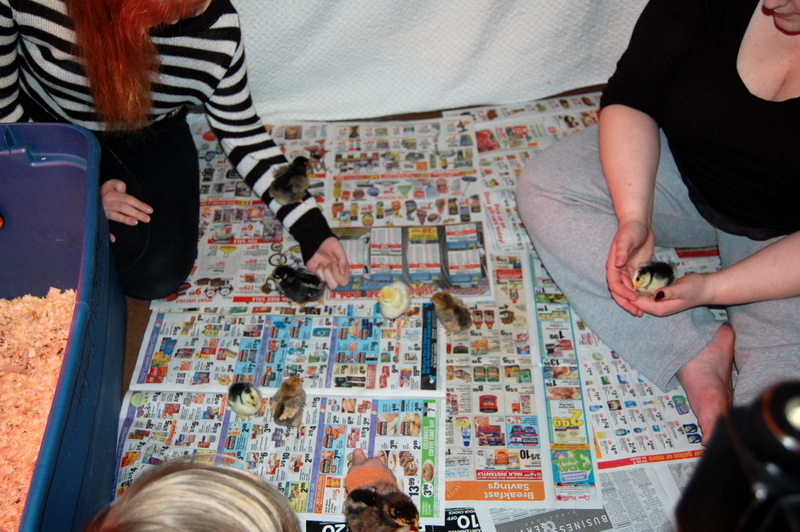
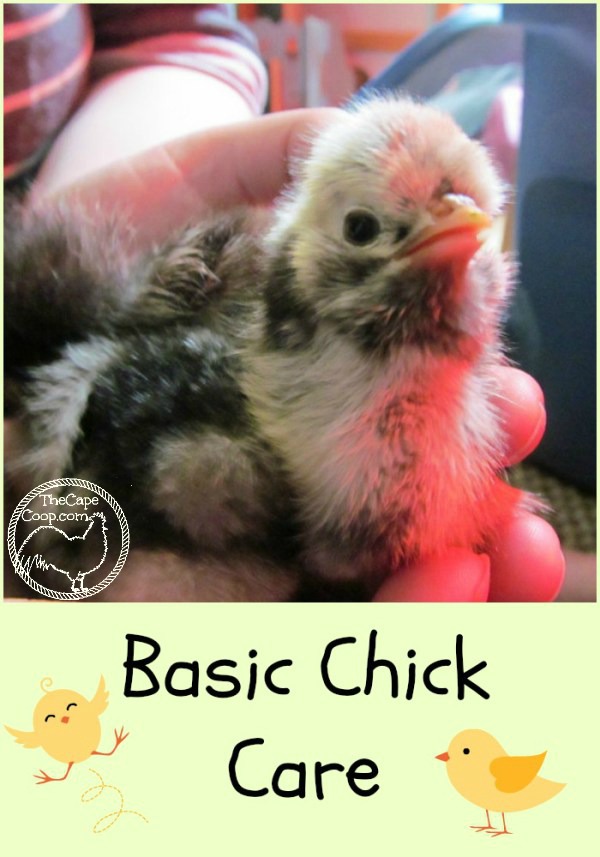



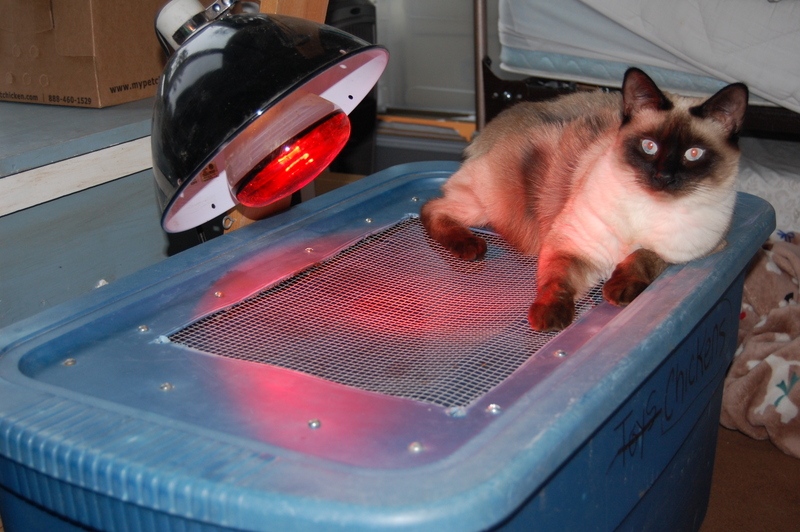
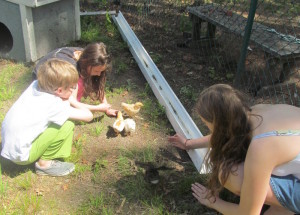


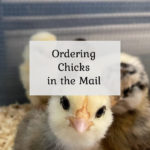
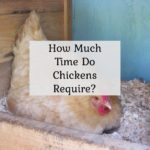
Robynne Catheron
Sunday 14th of March 2021
Fantastic information - thanks! ☺ What do you do about breeding? Do you have mixed-breed chicks, or do you separate the rooster(s) with their own breed, or...?
Also, I have four one-year old Guineas. Can I integrate chicks, keets and poults with them the same way as I would with chickens?
Liz
Monday 15th of March 2021
Hi! We just collect eggs daily so we aren't hatching babies regularly. Occasionally we will let a broody hen hatch out a clutch, and then yes the babies are all mixed breeds. Chicken breeds can all be mixed (just like a mixed breed dog), the resulting chicks are perfectly healthy, just not pure bred. Even though we have two roosters we generally order our chicks when we are expanding our flock. This way I can ensure they will all be female and our rooster population doesn't get any bigger!
I don't know a ton about Guineas, but I would imagine the integration would be similar with chickens
Siobhan thompson
Friday 8th of May 2020
What breeds do you have? I noticed some beautiful brown and grey ones and a grey one? I would love to know so I can look them up
Liz
Friday 8th of May 2020
These are our current birds: https://thecapecoop.com/our-animals/ but some of the photos around my blog are older with birds that have passed on. The brown & grey one is likely our Blue Laced Red Wyandotte or possibly one of the Easter Eggers (they come in lots of colors), and the grey one is probably a Blue Favaucana. I LOVE the grey/blue birds, they are so pretty!
Mina Yindra
Tuesday 30th of April 2019
Thank you so much for all the information! I’ll look all those starter kits up on Amazon, etc. I pretty much have to go with the plastic sides to prevent the drafts that I think the cardboard will let in, so I’m going prefab. I am going to have them on the nipple system in the coop and one enthusiast was rabid that chicks should be started on it immediately. I also have people who are rabid about putting the keets and 4-week chicks together, others who vehemently disagree. See what I mean? When you’re a first-time chicken buddy, everything that people agree on is fantastic! The other issues are what I’m hoping to have resolved at some point.
Mina Yindra
Tuesday 30th of April 2019
I would like to ask all the readers (and Liz, of course) a question about supplies for chicks. What I read here was similar to a lot of other lists as far as items for a good start in the home, but I also discover variances amongst others re: what I should get. I have 14 chicks arriving in 4 weeks and then 5 guinea keets a month later. I am NOT handy so pretty much need pre-fab everything. I am not worried about expense as long as I do everything right to give them the best start. I need to order soon to be sure I am set up- would you all be so kind as to let me know what you feel is a complete starter package for idiots who can't make one? As in, brooder plastic or cardboard, shavings, feed medicated or unmedicated, dishes, waterers (I believe I am going to use the nipple system), heat sources (I don't know if those heating platforms they can crawl under are safe and work well but they look great to keep the temp regular), a thermometer, whatever I could place in a rigid form over the brooder to prevent my dogs from becoming nosy, even though I am placing them on top of a large table, grit or no (I read what it said above re: grit once they are outside and eating bugs, etc. but other people have said no grit, others have said yes, and I'm not sure) Also, do I need two brooders to separate the keets from my 4-week old chicks or is it better to put them in together? I understand the guineas need socialization with the chickens to guarantee no "hard feelings" but I don't want either group injuring the other group. If there is anything else, please let me know. I purchased toys and then realized they were for grown chickens! Thank you all so much-
Liz
Tuesday 30th of April 2019
Congrats on your new babies! I know My Pet Chicken sells a chick starter kit where you can pick all the supplies you need: https://www.mypetchicken.com/catalog/Chicken-Supplies/Build-Your-Own-Baby-Chick-Starter-Kit-Save-big-p1742.aspx - makes it nice and easy! Manna Pro also sells a great all in one chick starter kit: https://amzn.to/2VBBj1F
19 birds is a lot for plastic bin, so you are probably going to want something larger like the cardboard panels in one of these kits. You could also use something like this: https://amzn.to/2VHZlIE but you will want to cover the sides with something in the beginning to keep the heat in. Or something like this will also work (and might be great to keep your dogs out): https://amzn.to/2LfmkGU
For the other supplies - I like pine shavings for bedding. I use unmedicated chick starter crumbles. You'll need a feed & water container for the birds. They sell easy feeder & water bases that you can just screw a Mason jar into (or sometimes you can buy a plastic jar to screw in). Those work great for chicks. I don't use the water nipple system, I tried it with my birds but they never took to it, so hopefully someone can chime in with some better suggestions for that. It might be difficult to set up in a brooder situation, so you might find it easier to use the water dish now and then transition them to the water nipples when they are older and outside. The heat platforms are the safest way to provide heat in the brooder. It lets the chicks choose when they need heat and when they don't and they don't have the fire risk that heat lamps have. They are much more pricey than heat lamps though. I still use a heat lamp with a red heat bulb in it, but I'd love to upgrade at some point. The other bonus of the heat platforms is that you don't have to rig up a system for suspending the heat lamp (which if you aren't handy is a big bonus!). Your chicks do not need any grit as long as all they are only eating chick feed. It's not going to hurt them, it's just not necessary. Grit is needed because chickens don't have teeth. They eat grit (sand & very small stones) and their body stores it in their gizzard. The grit acts as "teeth" to help break down the food. Chick feed is made to be easily digestible without grit.
I don't have any experience with keets but I am sure it is a good idea to get them used to each other. The chicks will be much bigger, just make sure they don't trample the keets when they come. Good luck!
Elizabeth Martin
Thursday 7th of April 2016
Thanks!